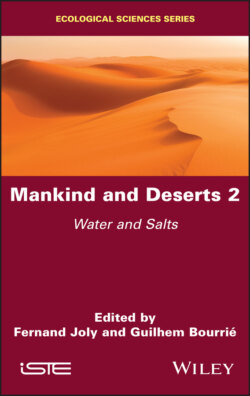Mankind and Deserts 2

Реклама. ООО «ЛитРес», ИНН: 7719571260.
Оглавление
Группа авторов. Mankind and Deserts 2
Table of Contents
List of Illustrations
List of Tables
Guide
Pages
Mankind and Deserts 2. Water and Salts
Foreword. Mankind and deserts
Acknowledgments
Introduction: Water in Deserts
I.1. Hydrology – wild water
I.2. References
1. Water Falling onto Soil and the Effects It Produces. 1.1. The arrival of water
1.2. Weathering
1.2.1. Thermoclasty
1.2.2. Hygroclasty
1.2.3. Cryoclasty
1.2.4. Haloclasty
1.2.5. Biodegradation
1.2.6. Chemical changes
1.2.7. Desert varnish
1.2.8. Conclusion on weathering in the arid zone
1.3. Runoff
1.3.1. Diffuse runoff
1.3.2. Concentrated runoff
1.4. Geodynamic and geomorphological effects of runoff in arid zones
1.5. Groundwater
1.5.1. The penetration and circulation of water at a depth
1.5.2. Groundwater reserves
1.5.3. Large hydrogeological basins
1.6. References
2. Temporary Water Bodies and Lakes
2.1. Water bodies
2.1.1. Elementary water bodies
2.1.2. Playas
2.2. Lakes
2.2.1. Inland seas
2.2.1.1. The Caspian: Central Asia. 42°0′N, 50°30′E
2.2.1.2. The Aral Sea: Central Asia 45°0′N, 60°0′E
2.2.2. Endorrheic lakes
2.2.2.1. Subtropical desert aridity. 2.2.2.1.2. The Dead Sea, Near East 31°30′N, 35°30′E
2.2.2.2. Regions with hot desert aridity. 2.2.2.2.1. Lake Chad, Sahara (Sahel) 13°20′N, 14°0′E
2.2.2.2.2. Lake Eyre, Australia 29°0′S, 137°15′E
2.2.2.3. Regions with cold desert aridity. 2.2.2.3.1. Lake Balkhash, Central Asia 46°0′N, 74°0′E
2.2.2.3.2. Lob Nor, Upper Asia 40°20′N, 90°15′E
2.2.2.4. Arid regions in the mountains. 2.2.2.4.1. Issyk-Kul, Upper Asia 42°25′N, 77°15′E
2.2.2.4.2. The Great Salt Lake, Utah, North America 41°10′N, 112°30′O
2.2.2.4.3. Lake Titicaca, South America 15°50′S, 69°20′O
2.2.2.4.4. Lakes in the Tibetan Plateau, Upper Asia 30°0′ to 38°0′N, 80°0′ to 100°0′E
2.3. The principal features of lakes in an arid zone
2.4. References
3. Hydrographic Networks
3.1. Endorrheism–arheism
3.1.1. Endorrheism–arheism in tropical deserts
3.1.2. Endorrheism–arheism in temperate deserts
3.1.3. Endorrheism–arheism in mountain deserts
3.2. The disruption of hydrographic networks
3.3. Allogenous rivers and streams
3.3.1. Intrazonal allogeny
3.3.1.1. Streams and rivers in a Mediterranean climate
3.3.1.1.1 The Tigris and the Euphrates
3.3.1.2. Streams and rivers in “temperate”, continental, steppe deserts in the Northern Hemisphere, lying between 30°N and 50°N, largely in Asia
3.3.1.2.1. The Amu Darya and Syr Darya
3.3.1.2.2. The Tarim
3.3.1.2.3. The Colorado
3.3.1.3. Streams and rivers in tropical or sub-tropical hot deserts, characterized by high temperatures through the year (over 25°C on average)
3.3.1.3.1. The Indus
3.3.1.3.2. The Senegal
3.3.1.3.3. The upper Niger
3.3.2. Interzonal allogeny
3.3.2.1. The middle and lower Niger
3.3.2.2. The Shari
3.3.2.3. The Huang He (Yellow River)
3.3.2.4. The Nile
3.4. References
4. Salts in Deserts
4.1. The nature of the salts
4.2. The origin of salts and evaporite sequences. 4.2.1. Evaporites
4.2.2. Evaporite sequences. 4.2.2.1. Ion chromatography in the landscape
4.2.2.2. Equilibrium and non-equilibrium in the precipitation of salts
4.2.2.3. Alkalinity and residual alkalinities
4.3. Evaporation of seawater
4.4. Evaporation of continental freshwater
4.4.1. The neutral saline path
4.4.2. The alkaline path
4.4.3. The acidic path
4.5. Systems mixing surface water and deep water. 4.5.1. The Saharan system
4.5.2. Potash deposits
4.6. Atmospheric origin of nitrate deposits
4.7. Mankind and salts
4.8. References
List of Authors
Index. A
B
C, D
E
F, G
H, I, J
K
L, M
N
P
S
T, U, V
W, Y
WILEY END USER LICENSE AGREEMENT
Отрывок из книги
Series EditorFrançoise Gaill
.....
Honorary Professor at the University Paris VII, Denis Diderot
October 2020
.....